A monolithic foundation is one of the most expensive types of foundation for a house. But on some soils, it is the only suitable option. It is also made in the construction of multi-storey buildings, when a particularly strong foundation is required. The article will discuss all aspects of pouring a monolithic foundation.
Advantages and disadvantages of a monolithic foundation
Reliability and high bearing capacity make it possible to install it in any type of construction. Technical characteristics are fundamental when choosing a monolithic slab foundation for the construction. Let's take a look at the most significant benefits below.
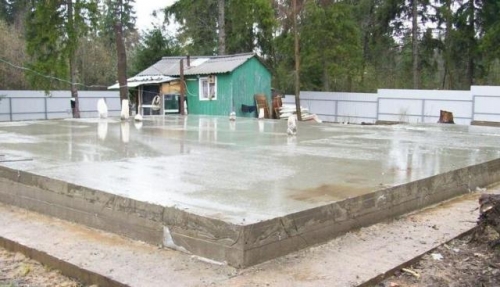
- No seams. It is their absence in the design of the plate that is considered the main advantage. This parameter provides a monolithic foundation with high strength even when the soil moves.
- Mounting speed. Since it is performed in a single area, time is significantly saved on the formwork device. And in the presence of construction equipment - an excavator, a mixer and a vibrating plate, the work is carried out in a couple of days. The longest process will be knitting reinforcement, which will require much more than with other types of foundations.
- Arbitrary configuration. Therefore, it will be an excellent option when the house has non-standard shapes, for example, decorated with bay windows.
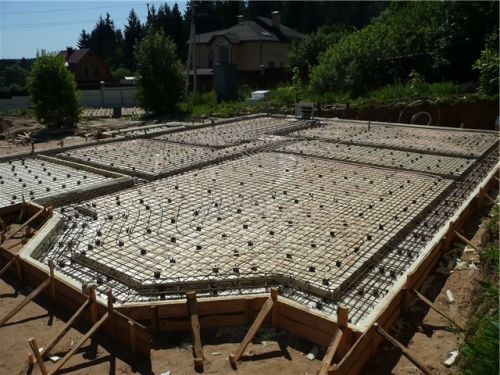
- Waterproofing. Due to the integrity of the structure, water will not penetrate into the basement and will not destroy the foundation of the house. A monolithic slab is recommended to be poured in wetlands or at a very high level of groundwater.
The disadvantages include the high price of pouring a monolithic foundation. In turn, it consists of a number of parameters:
- a large amount of concrete is required, and it must be poured at a time. And this means that you will have to order several mixers with a solution at a time;
- you can’t do without hiring construction equipment or renting expensive construction tools;
- Another point is associated with low thermal insulation properties. The foundation itself consists of concrete and metal wire, which only give off heat without holding it for a long time. This is corrected with the help of slab heat-insulating materials laid over the entire area of \u200b\u200bthe base;
- the impossibility of equipping the basement. The only exception will be a house with several floors, in which case the slab will become the floor in the basement, and the basement is allocated for the basement.
Types and application of monolithic foundations
There are three types of monolithic foundations.
- Tape. It is a reinforced concrete strip, equipped along the perimeter of the building and under the load-bearing walls. Suitable for construction on soils with medium bearing capacity.
- slab. Unlike the first type, it is poured in the form of a pita, under the entire area of \u200b\u200bthe building. They are used in earthquake-prone places and on weak ground, which can move with the change of seasons.
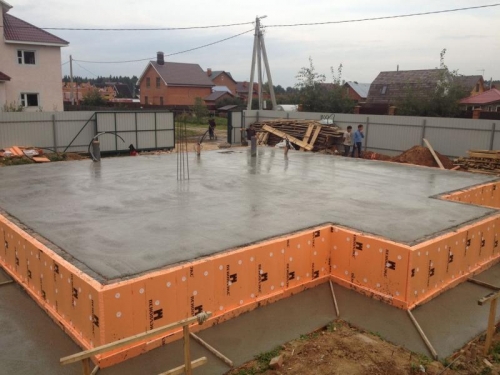
- Pile-grillage. It looks like concrete pillars buried below the freezing level and connected along the perimeter with a reinforced concrete grillage.
According to the depth of penetration into the ground are divided into:
- shallow monolithic foundation. In this case, the tile is mounted no deeper than 500 mm. It must be borne in mind that the soil under it freezes, so you need to make a thick sand cushion;
- to the freezing depth. It is made during the construction of multi-storey buildings. The slab is poured below the freezing level, which is at least 1500 mm for central Russia. This will require long and expensive excavation work, but the result will be a solid foundation with the possibility of arranging a basement.
The cost of a monolithic slab foundation
When calculating the cost, one must rely on the objective prices of building materials in each region. For example, consider the following values:
- pouring a monolithic foundation 30 cm thick;
- ordering a mixer with concrete, the price per cubic meter is 3500 rubles;
- fittings for knitting. It varies in diameter, but on average the price is per ton and is about 25 tr. Cell size 20x20 cm;
- all work on pouring the foundation is carried out independently, without hiring workers.
Thus, the cost of a 10X10m slab will be 120 tr.
Pouring a monolithic foundation photo
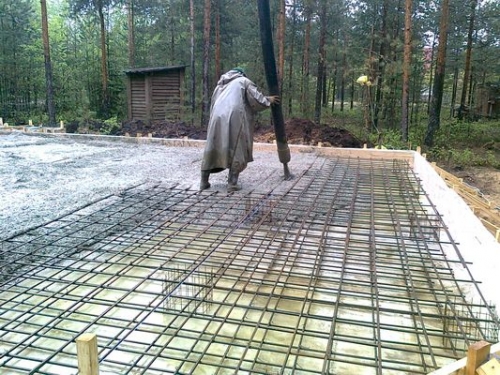
Preparation before pouring a monolithic foundation slab
Due to the fact that this type of foundation is used in difficult conditions on moving soils, increased requirements are placed on it. Therefore, if you want to save on the construction team and do all the work yourself, you must not only learn the right technology, but also follow it at every stage.
- Before the construction of a monolithic reinforced concrete foundation, a site is prepared for it. The territory is completely cleared, entrances for large equipment are being prepared.
- Then the future foundation is marked and a layer of soil with vegetation is removed over the entire area. At this stage, it is possible to carry out preparatory work on the arrangement of the blind area.
- Then comes one of the most time-consuming and responsible processes - digging a pit. Depending on the type of foundation, the depth will vary from 500 to 1500 mm, and the width is 1 - 1.5 m more than the foundation itself. Despite the fact that the concrete mixture is plastic and will level itself in a horizontal plane, the bottom of the pit should be as even as possible. This significantly affects the quality and reliability of the foundation. Here you can not do without the services of an excavator. It is desirable that it has a smooth bucket without teeth, which will allow you to make an even cut without mixing different layers of soil with each other and without loosening the surface.
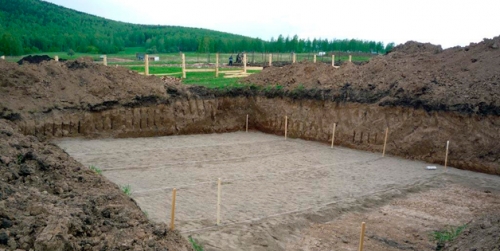
Tip: in order to determine the depth of the pit, it is recommended to carry out preliminary geological exploration. Best of all, if the soil is sandy, then strong penetration is not required. The most unstable and mobile soil is clay. Ideally, it is recommended to select it completely and dig below the freezing level.
Monolithic foundation pouring technology
- Now it's time to make a multi-level pillow under a monolithic foundation. To do this, the geotextile material is laid in the first layer, the higher its density, the better. It performs the function of a layer between gravel and sand (or ASG), not allowing the latter to go into the ground. If the layer thickness does not exceed 20-30 cm, then sand can be laid on top, if the monolithic foundation is very deep, then you can save money and start ASG. After that, everything is rammed with a vibrating plate until a person can walk on the surface and not fall through.
Tip: at the stage of arranging the pillow, communications such as sewerage and water supply should already be provided and laid. So that in the future it would not be difficult to bring them into the house.
- Next comes another layer of geotextile, on top of which, this time, crushed stone with a fraction of 30-40 mm and a thickness of 20-30 cm is poured. It is also compacted and rammed.
Tip: at this stage it is important that the surface level is strictly in a horizontal plane. This can be done with an optical level. And it is convenient to check the corners with a laser level.
- Now it's time for waterproofing. It is best to use rolled waterproofing material, which is laid out over the entire surface with small overlaps of the strips on top of each other.
- Then comes the insulating material. Here, you should stop your choice on foam plastic, since it has a higher density than polystyrene, has better characteristics, does not crumble, and most importantly, mice do not gnaw it. In order to exclude possible cold bridges, it is better to lay the material in two layers in a checkerboard pattern, in this case it is necessary to buy plates with a thickness of 50 mm.
- If the lower layer is laid over the area of the entire pit, that is, insulating them with protrusions of 1.5 meters each, then the upper one is laid strictly according to the size of the foundation. This step allows you to ensure that the blind area will be insulated without gaps.
- The turn of formwork has come. You should not buy a low-grade board, the material must be dried, without rot and wane (in the future it can be disassembled and used in construction). The thickness of the board directly depends on the foundation, so for a shallow one, a thickness of 25-30 mm is enough, for deeper ones, 50 mm is required.
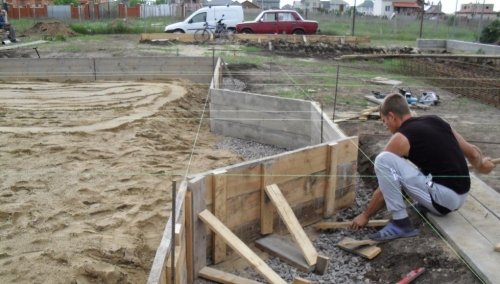
- From the prepared material, shields are knocked together or fastened with self-tapping screws. To strengthen them, vertical bars are screwed every 50-60 cm. Then they are mounted around the perimeter of the future slab, thereby creating a formwork. At the end of the work, you need to check the diagonals and angles again. After making sure that everything is done correctly, the formwork is fixed with pegs in increments of 50-80 cm, the corners are fixed and spacers are placed on the outside, which make it possible to better hold the structure when pouring concrete.
- Next is the reinforcement of the monolithic foundation. This time-consuming and crucial moment will affect not only the reliability of the foundation itself, but also the strength of the future home. The type of reinforcement depends on the building, so for small one-story houses or garages, a reinforcing mesh with a cell of 10 cm is suitable. When building a heavy brick or two-story house, it is optimal to use reinforcement with a diameter of 15-20 mm. It is desirable that it has ribs for better adhesion to the concrete mixture.
- But there is a nuance here. Obviously, the thicker the reinforcement, the more reliable the base will be and the greater the load it will be able to endure. But given that it fits and fits in several rows, it will take up a lot of space and, therefore, less concrete will fit.
- For example, consider reinforcement with 16 mm bars and with a cell size of 20x20 cm. Before starting work, it is necessary to organize a gap between the base and the first row of reinforcement, which must be at least 5 cm. For this, there are special stands for sale.
- It will be possible to achieve the desired strength only when knitting; it is impossible to cook reinforcement. To do this, there are special devices from inexpensive household to serious professional ones.

- It is best when the reinforcement is laid in one piece, without cutting. That is, with a standard size of a reinforcing bar of 11.7 m, laid in a foundation 10 m long, the extra 1.7 meters are cut off. But this is not always possible, for example, when the width of the house is larger or the material was brought in by car and was shorter in length. In this case, the reinforcement is knitted with an overlap of 10 cm.
- When the first layer is connected and mounted, it's time for the next one. The allowable distance between them is 20-30 cm. The distance between the reinforcement and the formwork varies between 3-6 cm.
Pouring the foundation with concrete
- When the sand cushion is made, the formwork is assembled and the reinforcement is mounted, it is the turn of pouring the slab with concrete.
- At this point, the required amount of solution and its brand should already be calculated. It is also necessary to take care of the access routes, since a fully loaded mixer weighs a lot, and it will need to drive up close to the formwork.
Tip: when pouring a large volume of mortar, it is preferable to order a machine equipped with a concrete pump. With a shallow foundation of a small size, an automixer with a conventional pull-out tray is quite suitable.
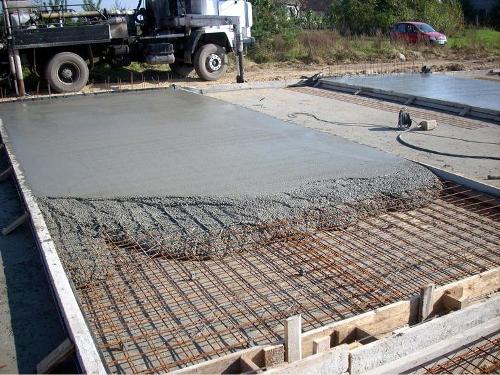
- Concrete is chosen based on its brand, which is responsible for the strength of the composition during solidification. This is due to the fact that the higher the brand of the mixture, the more cement in its composition. Based on SNiP, this parameter for concreting the foundation should not be lower than M-250.
- As already mentioned above, it is best if concreting is done at a time. If you take a break, the previous pour will harden and a seam will form at the junction. In the future, in its place, there is a high probability of a crack appearing.
- When filling, air bubbles are formed, which adversely affect the final result. To remove them, the base, if possible, needs to be vibrated. After that, the foundation is covered with a film.
- Formwork can be dismantled no earlier than after 7 days, and construction can begin even later. Only after 2 weeks concrete gains its strength.
Pouring a monolithic foundation video



